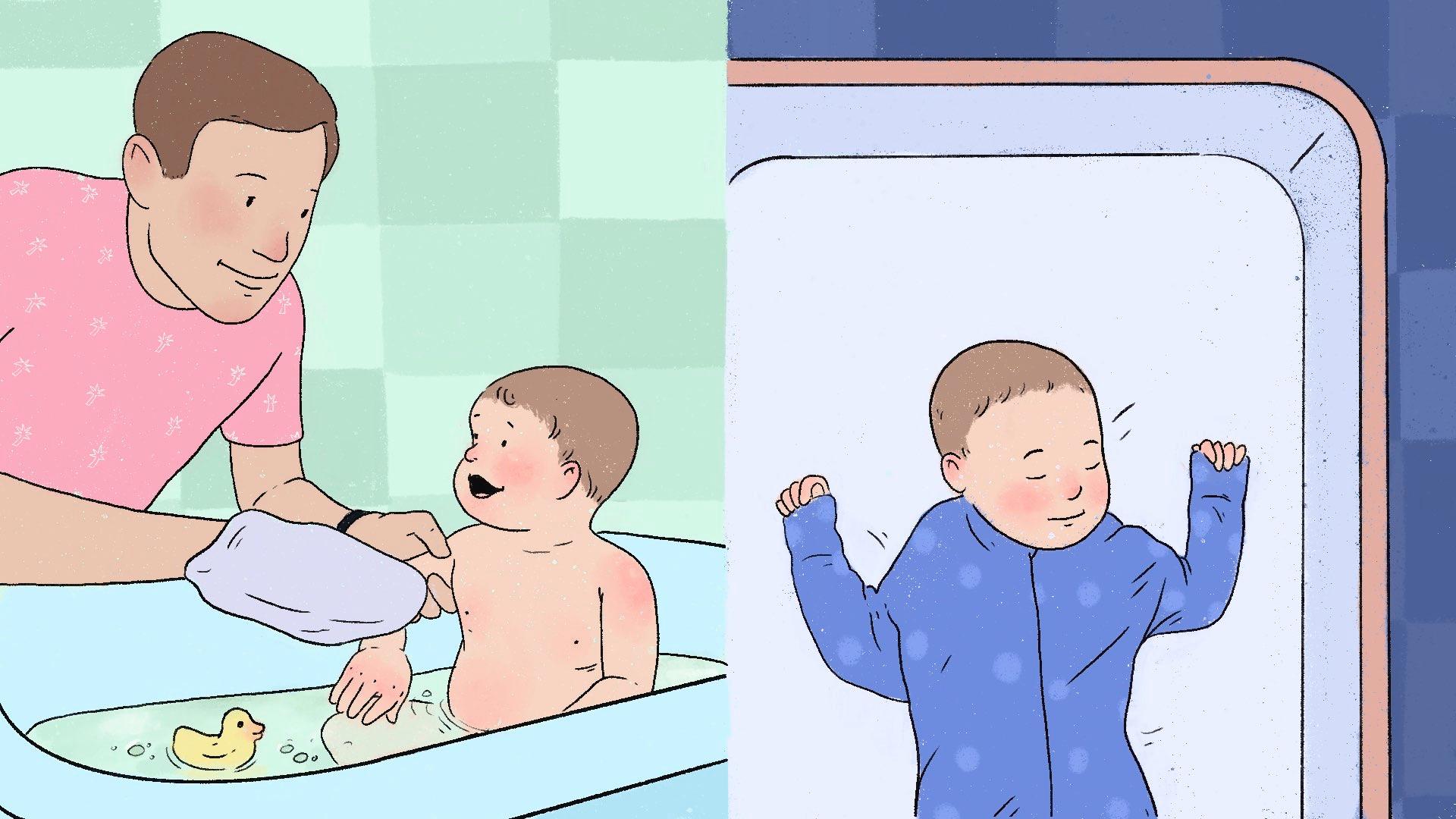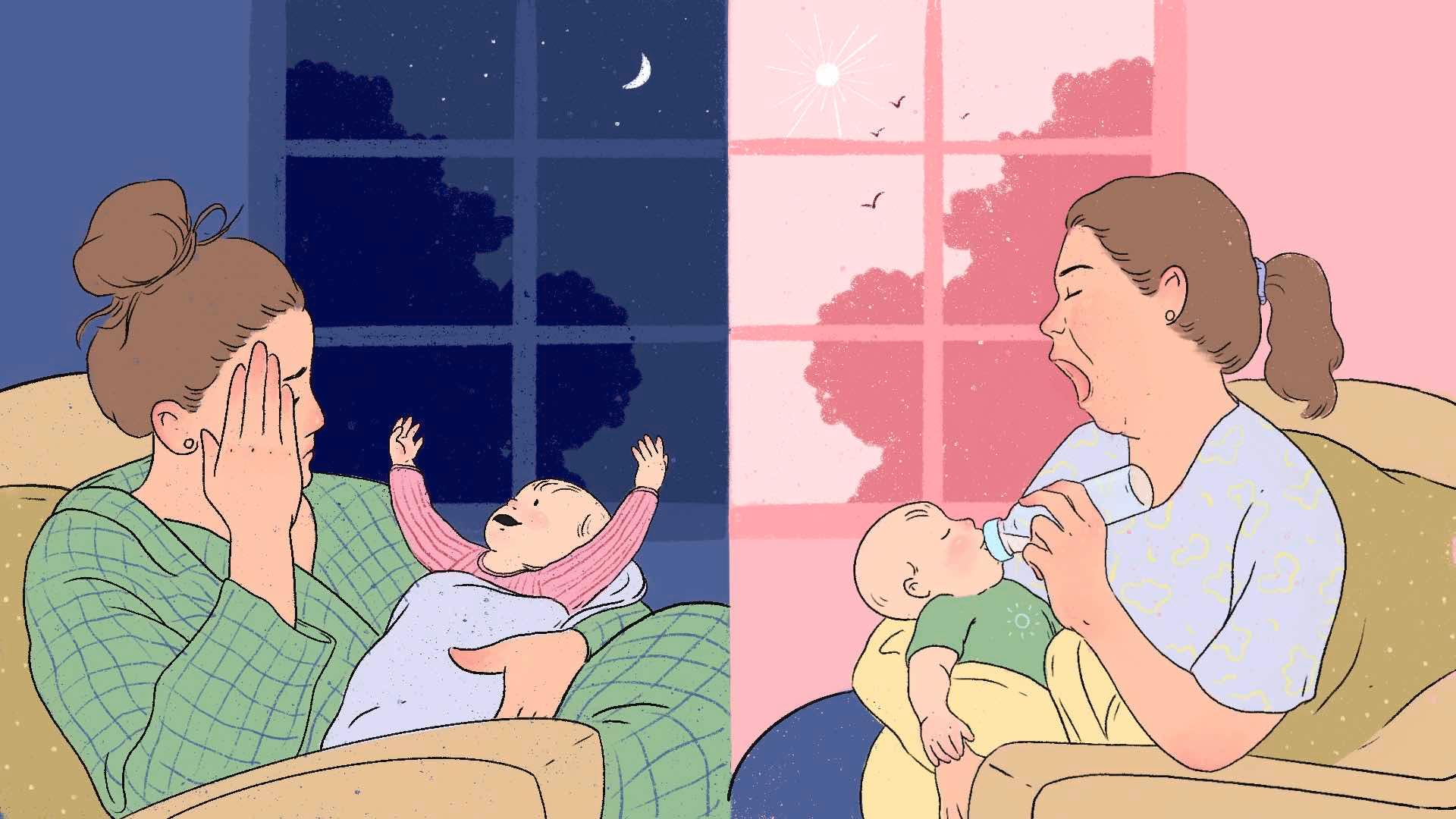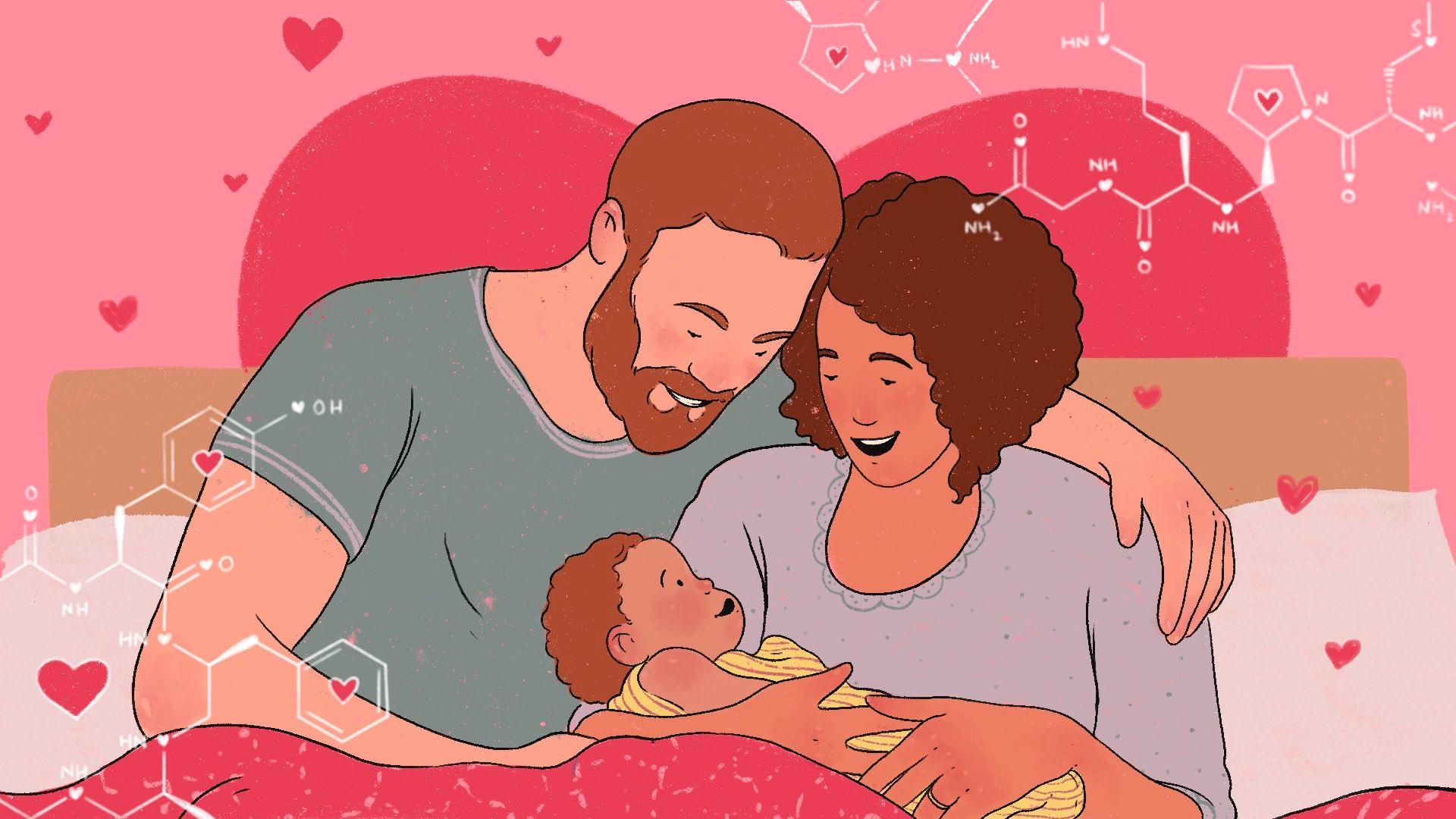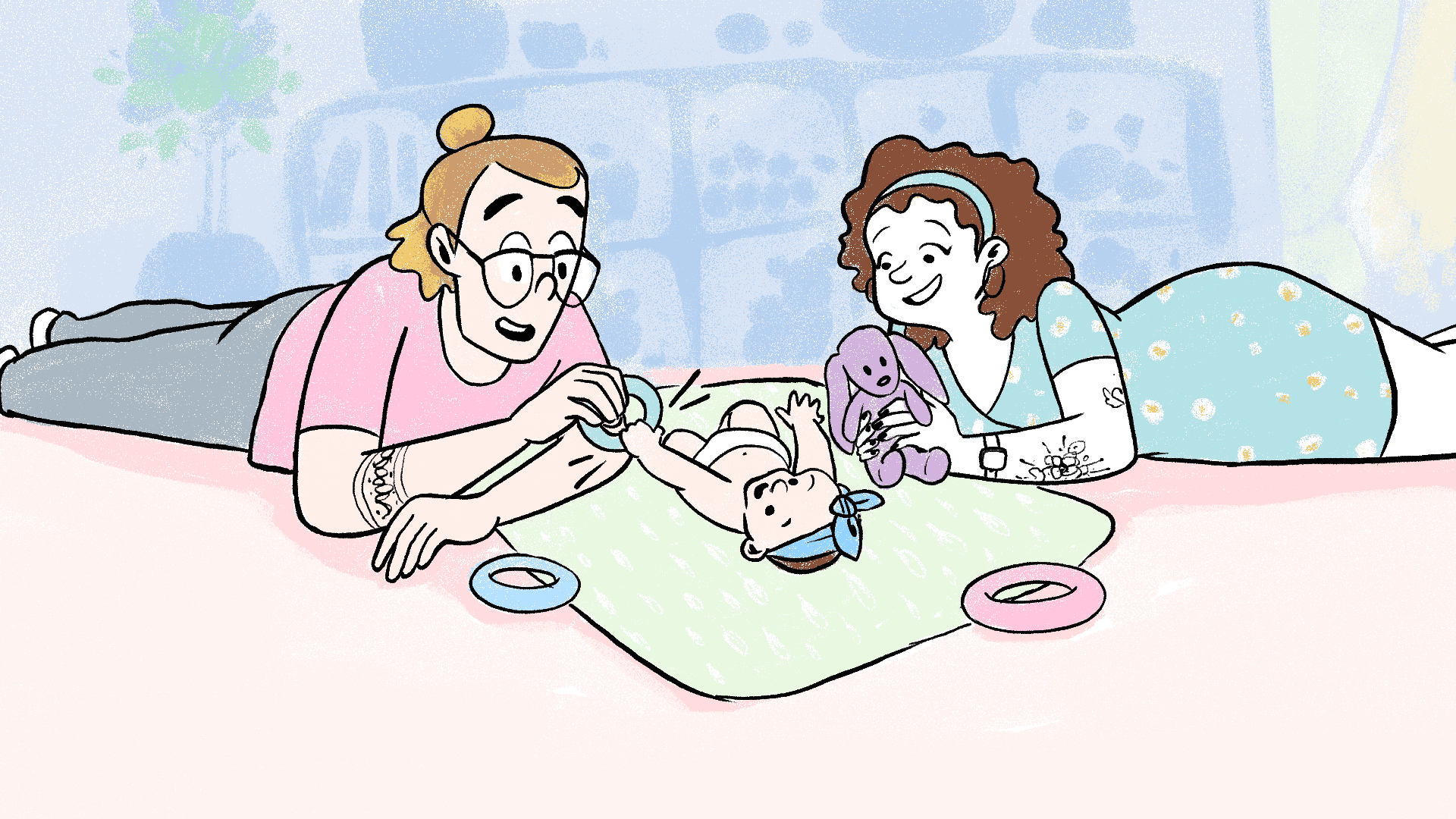

Night sleep
11-12 hours

Daytime naps
3-4 hours

Total sleep
15 hours
It’s happened: Seemingly overnight, your baby is nearly a quarter of a year old—that’s right, we’re talking about the 3-month mark.
As you approach 3 months, there are many reasons to be excited. Your baby’s personality is continuing to flourish, and they will happily share coos and smiles.
They may even copy your facial movements—try sticking out your tongue, and see how they respond. Tasks that may have flummoxed you during the early days, like feeding and diaper-changing, are so familiar you could probably do them in your sleep—and some nights, it might feel like you do.
Speaking of sleep, 3-month-old babies also tend to be much calmer in the evenings, and you’ll likely have an easier time getting them to bed than even just a month ago.
During the third month, you may start to see overnight snoozing periods get longer and a predictable morning nap may start to take shape, but it’s also considered normal if your little one’s nap times are still a bit irregular.
You should also get ready for a whole slew of developmental milestones that happen around the 3-month mark, like swiping at or grasping toys, tracking objects with their eyes and holding their head up for at least a few seconds.
Finally, babies at this age are becoming increasingly curious about the world, and better able to communicate how they’re feeling, not by talking yet, obviously, but by cooing, crying and smiling.
3-month-old baby milestones for sleep
By month 3, 85 percent of babies who were previously colicky will no longer be; the remaining 15 percent will be colic-free by month 4. This doesn’t mean you’ll never hear crying—on average, 3-month-olds still cry for about an hour total each day.
But you may find that it’s easier to soothe your baby to sleep, by the time they are 3 months old, they may sleep uninterrupted stretches (6 hours or so) without needing to eat. However, many babies are not ready for this step, and will still need one or two feedings overnight, especially if they are nursing.
It’s tough, but try not to get caught up comparing your little one to babies in your parents’ group or the ones being flaunted on Instagram.
You’ve probably been working diligently on making sure your baby fits in tummy time, and during the third month, you’ll start to see their practice pay off.
As the neck and shoulder muscles strengthen, you’ll see them lifting their head when placed on their stomachs, though you may still be a few weeks away from witnessing the adorable mini pushup.
By the end of the third month, some babies may be strong enough to roll from tummy to back, which is why it’s so important to keep a close eye on them when they’re on their play mat. For most babies though, rolling won’t happen until around four months.
Another cool thing that’s coming into play is hand-eye coordination. You’ll notice your baby bringing their hands towards their mouth, which can eventually help with self-soothing.
They should also be swatting at toys and trying to grasp them, though they may still drop them frequently (to avoid frustration, stock your arsenal with plenty of soft, lightweight options).
More good news about sleep: Around the 10- to 12-week mark, the initial signs of a circadian rhythm appear, which is why you’ll notice your baby having an easier time snoozing overnight. (Thanks, Mother Nature.)
What’s going on in your baby’s brain?
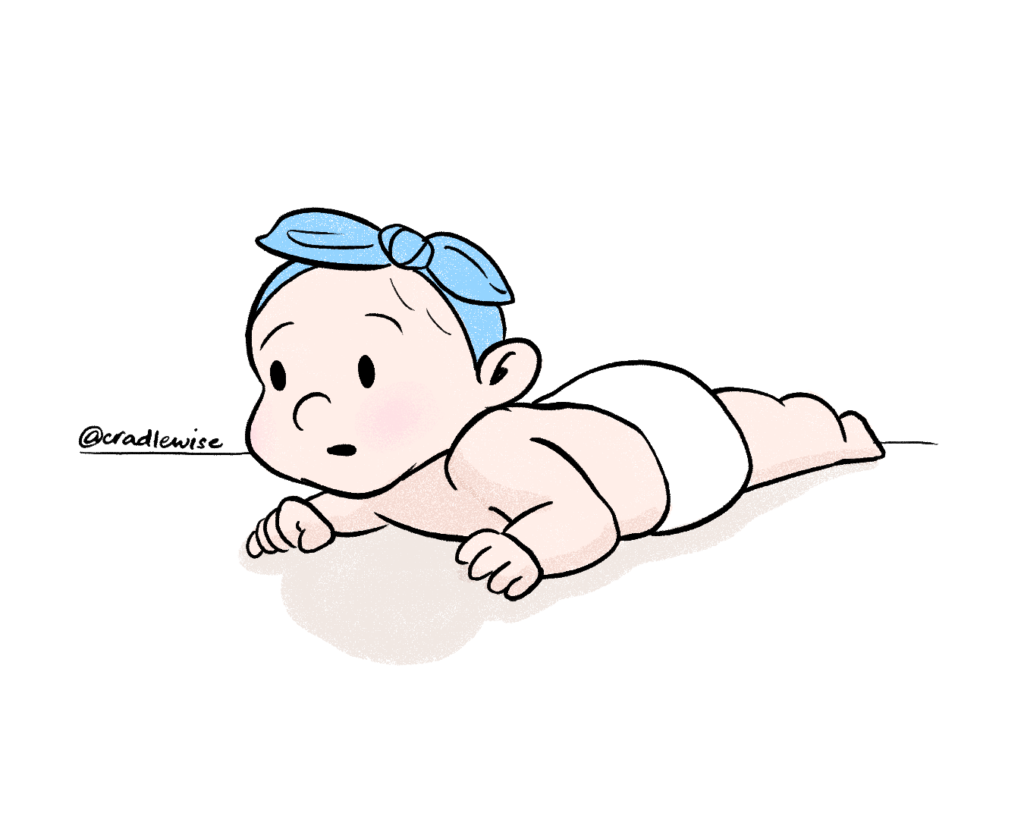
At this point, most, if not all of your baby’s infant reflexes have probably disappeared. Instead, you’ll see more purposeful movements, such as opening and closing hands and kicking legs.
The American Academy of Pediatrics (AAP) has a developmental health watch, which includes milestones you’ll want to discuss with your pediatrician at well visits.
For the 3-month mark, you’ll want to let your doctor know if your child still isn’t doing things like grasping toys, tracking moving objects and imitating sounds and facial expressions. (Here’s the full list.)
Your baby’s vision is continuing to sharpen. By 3 months, they’ll be able to see things from several feet away, and they will also start to become obsessed with circular images such as individual faces, as well as bulls-eyes and spirals.
You can stimulate their curiosity by getting board books that include photos of people’s faces or graphics of high-contrast patterns, like this one, which features bullseyes and a fold-out mirror.

Crib Notes
Babies don’t have regular sleep cycles until they’re around six months old. Since they wake frequently (sometimes every hour), Cradlewise can help by soothing them back to sleep before they start crying, resulting in more rest for them and for you, which is a serious win-win.
How much should a 12-week-old baby sleep?
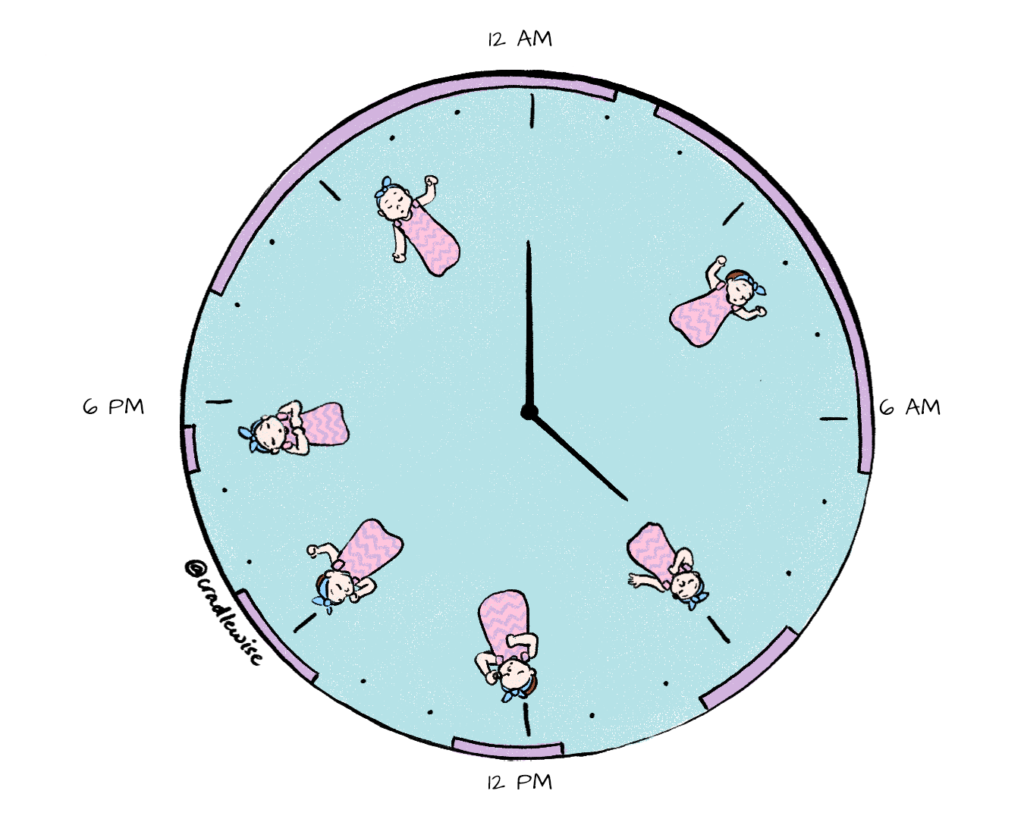
You should keep following your baby’s cues, but also take comfort in knowing that things will start feeling a bit easier and more stable as the weeks progress, especially since their overall sleep requirement has gone down, and overnight sleep stretch should be increasing.
- Total hours of sleep: Hurray! Your baby needs fewer hours of sleep than they did last month; it’s now down to about 15 hours within a 24-hour period.
- Wake windows: It’s still prudent to aim to have each period of “awake time” be shorter than two hours, and many babies will be ready for sleep sooner, like around 90 minutes.
You should continue to soothe your child before they show signs of becoming overtired, and put them down in their Cradlewise when they’re drowsy but awake, so they can practice their own self-soothing skills.
- Number of naps: Your 3-month-old might sleep a total of 3 to 4 hours each day, either split into several shorter naps, or just 2 (one in the morning and one in the afternoon).
Sample 12-week-old baby sleep schedule
Keep in mind that this is just an example. Your baby may be taking fewer naps that are longer in duration. But ideally they won’t be awake for longer than two hours at any given point during the day.


Infant feeding tips
Your baby’s weight is increasing, but their rate of growth from birth hasn’t changed; it’s still about 1 ½ to 2 pounds for weight and 1 to ½ inches for length each month.
- How much should a 3-month-old weigh: The average weight for a 3-month-old is 12 pounds 14 ounces for girls, and 14 pounds 1 ounces for boys, but as long as your baby is continuing to follow their percentile curve from birth, your pediatrician likely won’t have concerns.
Although you may not have a 3-month well visit, you should always contact your pediatrician if you’re concerned about your baby’s breastmilk or formula intake. They should be making at least six wet diapers in a 24-hour period, and their urine should be pale and mild-smelling (darker pee could indicate dehydration). - How much should a 3-month-old eat: Your baby is still taking in about 4 to 5 ounces per feeding every 3 to 4 hours, but if you notice their demand increase by the end of the third month, welcome to yet another milestone: the 3-month growth spurt.
You might remember this from the six-week mark, and the experience will be similar. Your little one may start waking in the night again to eat, or acting like more of a fusspot than usual. But stay the course, and within a few days they’ll be back to their old self, plus a few additional, adorable ounces. - Tip: You should continue to offer breastmilk or formula to your baby, rather than solid food, since the AAP suggests that parents wait to start solid food until around six months old, or by four months at the very earliest.
Some parents still like to burp after every few ounces, or for those nursing, each time the baby switches breasts. But with your baby sitting up more, you might notice that they don’t need as much help being burped, and do just fine getting those belches out themselves.
You can still watch for signs of discomfort, such as crying, arching their back or looking strained, and give them help when they need it.
- When will my 3-month-old begin teething? Most babies start teething after four months, but there are some early bird teethers who get their first tiny teeth right around the 3-month mark.
When a new tooth is on the cusp of erupting, you might notice that your baby is drooling and trying to bite various objects (you’ll want to give them alllllll the teething toys).
They might also be waking up more frequently, less interested in eating, or more cranky. If you’re concerned, ask your pediatrician about medications that might make them more comfortable, like acetaminophen, or home remedies such as massaging their gums or offering frozen washcloths for chewing.
You’ll probably see the lower set of the central incisors come in first; these are the teeth that are front and center in the mouth, at the bottom.
Teething and drooling go together like salt and pepper, but in rare cases, drooling can be a sign of something more serious.
The AAP outlines certain cases where increased saliva production, along with symptoms like fever, mouth ulcerations or difficulty breathing, would require you calling your pediatrician or 911.

Crib Notes
If your baby is teething, you might try using the app to adjust Cradlewise’s bounce duration or level to help soothe them back to sleep.
How to help support your baby’s sleep during the third month
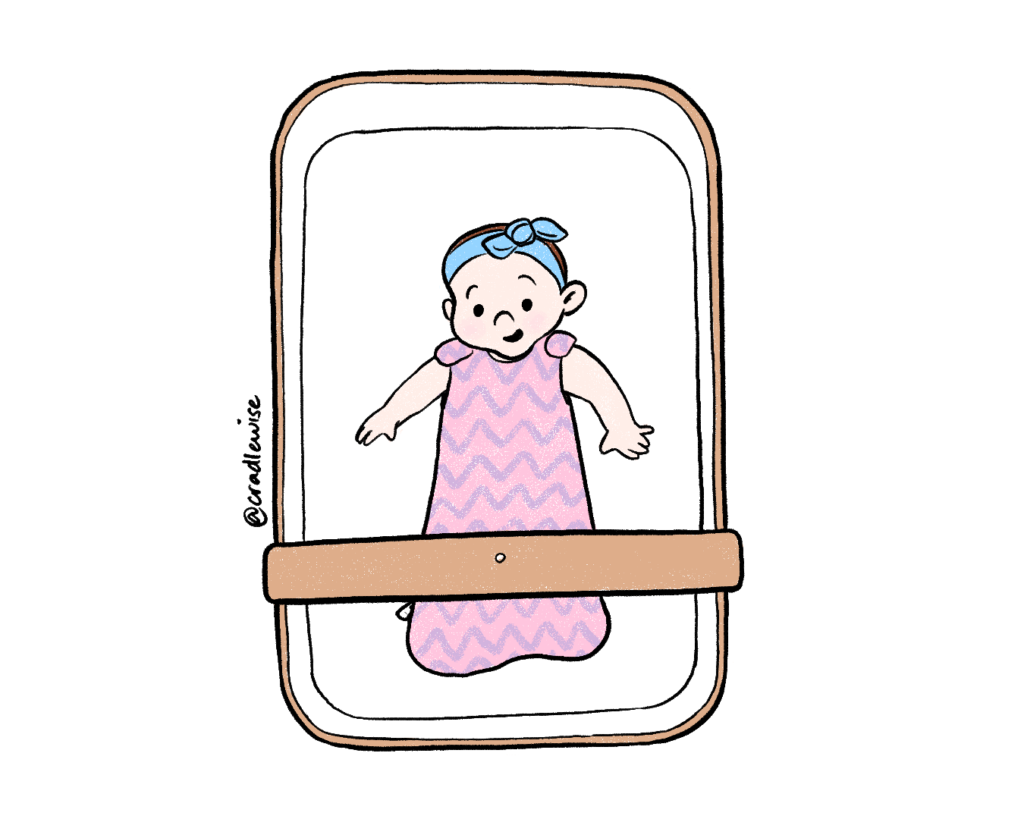
During the third month, you should continue to follow your baby’s cues and not stress out too much about getting them on a specific schedule. But you will start to notice some predictable patterns, which can be comforting, especially for first-time parents.
Stop the swaddle.
Stop the swaddle.
You might love wrapping your little one up like a burrito in a nifty blanket, but the AAP recommends discontinuing swaddling when your baby shows signs of trying to roll, which could be as early as two months of age (you might notice rocking first). The concern is that if your baby does manage to flip, they could become trapped in their blanket and suffocate. You can try weaning from the swaddle slowly, leaving one or both arms free, or just completely removing it, and trying a sleep sack in its place. Some parents and caregivers notice a bit of a sleep regression for a few nights once their baby no longer wears a swaddle, but the good news is that Cradlewise will still be around for safe, familiar soothing.
Embrace “sleep begets sleep.”
Embrace “sleep begets sleep.”
It’s a cycle: In order for your baby to take solid naps during the day, they should be well-rested overnight, and in order for them to go to sleep easily at bedtime, they should have napped well during the day. Being awake for too long (remember the two-hour window?) can cause babies to become overstimulated. In this case, “overstimulated” doesn’t refer to going wild playing at a birthday party or watching too many shows in the evening. It means that if they are awake for too long a stretch, they not only become grumpy, they also get a second wind which makes sleep that much more elusive. There’s science behind this, too: When we become overtired, our bodies actually produce stimulating hormones to try and combat the feelings of fatigue and keep us awake.
Strengthen the bedtime routine.
Strengthen the bedtime routine.
Three months is a great age to solidify your child’s bedtime routine. At the very least, you’ll need to change them into a fresh outfit and diaper, and brush their teeth (if they have any). You might also add a bath, a lullaby, a favorite song recording or a short book. Some parents aim to feed the baby first, so they don’t associate eating with sleep, and put them down drowsy but awake, so they can practice falling asleep without help. Ideally the bedtime routine happens in the same order each evening (children love consistency), takes less than 30 minutes to complete and can be easily replicated by other caregivers.
Lean on sleep aids.
Lean on sleep aids.
Whether your baby is teething or experiencing some other kind of three-month sleep regression, you can play with the crib ‘Sensitivity’ on Cradlewise, increasing it if your little one seems to be having a tough time. You can also continue to use Cradlewise’s music or the options for white, pink or brown noise to help drown out distracting sounds and create a soothing atmosphere.
Favor early bedtimes.
Favor early bedtimes.
Aim for a bedtime around 7 or 8 p.m., depending on when your baby last napped. Babies who go to bed after 9 p.m. may risk becoming more overstimulated and having a harder time falling asleep, which is not fun for anyone in the family.
Practice good sleep hygiene.
Practice good sleep hygiene.
Continue with the strategies you’ve been using, like keeping your baby away from screens and other sources of blue light during the two hours before bed, encouraging naps in their Cradlewise (rather than the stroller, car or carrier) and dimming the lights in your home when it’s time for sleep.
FAQs
Q: How much nighttime sleep does a 3-month-old need?
A:11 to 12 hours with one overnight feeding.
Q: How long are 3-month-old wake windows?
A: Awake time for a 3-month-old baby should be shorter than 2 hours. Many babies at this age start to get tired after 90 minutes of being awake.
Q: How many naps for a 3-month-old?
A: 3 to 4 hours of nap time split between several short naps or 2 longer naps.
Q: How much should a 3-month-old weigh?
A: The average weight for a 3-month-old is 12 pounds 14 ounces for girls, and 14 pounds 1 ounces for boys.
Q: How much should a 3-month-old eat?
A: 4 to 5 ounces per feeding every 3 to 4 hours.
More posts you might like:
- 4-month-old baby sleep guide
- 5-month-old baby sleep guide
- 6-month-old baby sleep guide
- 7-month-old baby sleep guide
- 8-month-old baby sleep guide
- 9-month-old baby sleep guide
- 10-month-old baby sleep guide
- 11-month-old baby sleep guide
- 12-month-old baby sleep guide
Sources:
- 3-month-old babies become calmer in the evenings. 2021. Healthy Sleep Habits, Happy Child, Fifth Edition.
- 3-month-olds cry for about an hour each day. 2016. Zero to Three. Birth to three months: Your baby’s development
- Naps and overnight sleep around 3 months. 2021. Healthy Sleep Habits, Happy Child, Fifth Edition.
- Developmental milestones around 3 months. 2019. American Academy of Pediatrics: Caring for Your Baby and Young Child from Birth to Age Five, Seventh Edition.
- Tummy time milestones and hand-eye coordination. 2019. American Academy of Pediatrics: Caring for Your Baby and Young Child from Birth to Age Five, Seventh Edition.
- Circadian rhythms in 10- to 12 -week olds. 2017. Nature of Science and Sleep. Infant sleep and its relation with cognition and growth: a narrative review
- Newborn reflexes begin to fade during the second and third month. 2019. American Academy of Pediatrics: Caring for Your Baby and Young Child from Birth to Age Five, Seventh Edition.
- Four types of developmental milestones. 2009. HealthyChildren.org. Developmental milestones: 3 months.
- Babies don’t have regular sleep cycles. 2018. HealthyChildren.org. Getting your baby to sleep.
- Baby sleep needs by age. Stanford Children’s Health. Infant sleep.
- Number of hours of naps per day. Pediatric Sleep Council. Month 3.
- Baby weight gain per-day ranges. 2019. American Academy of Pediatrics: Caring for Your Baby and Young Child from Birth to Age Five, Seventh Edition.
- Average weight for a 3-month-old. Centers for Disease Control & Prevention. Data table for gIrls length-for-age and weight-for-age charts and data table for boys length-for-age and weight-for-age charts.
- Baby feeding frequency. 2022. HealthyChildren.org. How often and how much should your baby eat?
- Teething and 3-month-olds. 2018. HealthyChildren.org. Baby teething pain.
- Central incisors appear first. 2018. Nemours Kids Health. Teething tots.
- Drooling in 3-month-olds. 2016. HealthyChildren.org. Drooling and your baby.
- When to stop swaddling. 2020. HealthyChildren.org. Swaddling: Is it safe?
- Overstimulation and babies. 2021. Healthy Sleep Habits, Happy Child, Fifth Edition.
- Your baby may be ready for an earlier bedtime. 2019. American Academy of Pediatrics: Caring for Your Baby and Young Child from Birth to Age Five, Seventh Edition.
- Early bedtimes and bedtime routine ideas and duration. Pediatric Sleep Council. Month 3.
- Favor crib naps to avoid distractions. 2021. Healthy Sleep Habits, Happy Child, Fifth Edition.
You may also like

